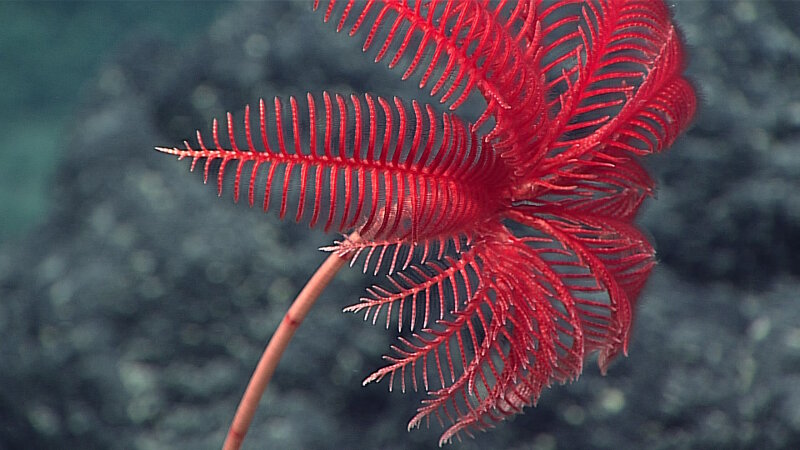
A beautiful stalked crinoid, likely Proisocrinus ruberrimus. Image courtesy of the NOAA Office of Ocean Exploration and Research, 2016 Deepwater Exploration of the Marianas. Download larger version (jpg, 1.1 MB).

A beautiful stalked crinoid, likely Proisocrinus ruberrimus. Image courtesy of the NOAA Office of Ocean Exploration and Research, 2016 Deepwater Exploration of the Marianas. Download larger version (jpg, 1.1 MB).
Chimaera
This Chimaera was seen during Dive 8 at a site known as Northwest Guam Seamount. These ghostsharks or rabbitfish are most closely related to sharks and rays and are now known only from deep water. Video courtesy of the NOAA Office of Ocean Exploration and Research, 2016 Deepwater Exploration of the Marianas. Download (mp4, 33.7 MB)
Blind Deep-sea Lobster
This deep-sea lobster, likely Acanthocaris tenuimana, was seen during Dive 8 at a site known as Northwest Guam Seamount. It was guarding a series of large burrows with claws poised for action. Video courtesy of the NOAA Office of Ocean Exploration and Research, 2016 Deepwater Exploration of the Marianas. Download (mp4, 44.3 MB)
Dive 8 occurred on the upper slope of the Northwest Guam Seamount. This seamount sits within the last major unexplored seamount arc in the southern Marianas, and we were particularly interested in this site because it seemed likely to host mature animal communities, including fish, corals, and sponges. The dive began at 1,319 meters, in a sedimented area with heavily manganese-encrusted outcrops and talus. About two hours into the dive, we encountered a dike outcrop with columnar jointing and fractures and collected a rock sample. After reaching the summit (~1,160 meters), we transited down the saddle between two local highs and headed upslope again to the west. In this area, the sediment showed ripple marks and was later stratified into dark and light sediments with sinuous, low-relief mounds. The few outcrops encountered on the second slope were heavily weathered and covered in manganese crust. We were correct in our hunch that we would see many fish at this site—we saw a hagfish; a ghost shark (Chimaera, Hydrolagus sp.); a deep-sea anglerfish (Sladenia remiger); a cutthroat eel (Synaphobranchidae); and a bathygagid, which is a fish closely related to rattails. We also saw a Polychelidae lobster – a very primitive species, a crab (possibly Paralomis sp.), chirostylid squat lobsters, black and bamboo octocorals, multiple sponge species, brightly-colored crinoids (including possibly a new species), and an egg-bearing squat lobster. We collected a bamboo coral (Lepidisis sp.) and a cladorhizid sponge that we believe may be a new species. Towards the end of the dive, we encountered numerous large burrows in the sediment. The origin of these initially stumped us, until we spotted a huge blind lobster (possibly Thaumastocheles sp.) popping its head out of one of these holes. We finished the dive soon after at ~1,200 meters.